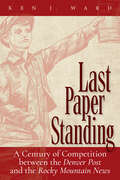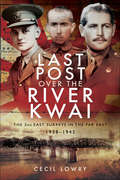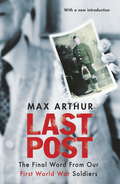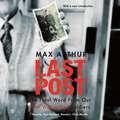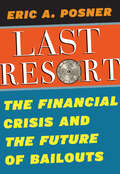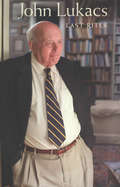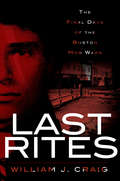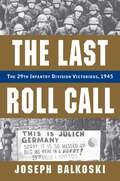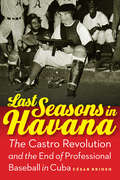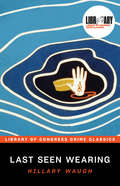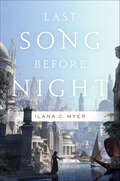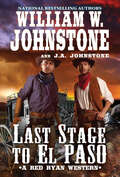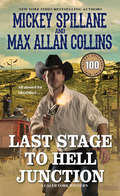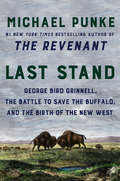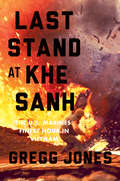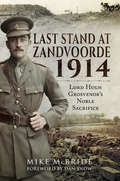- Table View
- List View
Last Paper Standing: A Century of Competition between the Denver Post and the Rocky Mountain News (G - Reference,information And Interdisciplinary Subjects Ser.)
by Ken J. WardLast Paper Standing chronicles the history of competition between the Denver Post and Rocky Mountain News—from both newspapers’ origins to their joint operating agreement in 2001 to the death of the News in 2009—to tell a broader story about the decline of newspaper readership in the United States. The papers fought for dominance in the lucrative Denver newspaper market for more than a century, enduring vigorous competition in pursuit of monopoly control. This frequently sensational, sometimes outlandish, and occasionally bloody battle spanned numerous eras of journalism, embodying the rise and fall of the newspaper industry during the twentieth century in the lead up to the fall of American newspapering. Drawing on manuscript collections scattered across the United States as well as oral histories with executives, managers, and journalists from the papers, Ken J. Ward investigates the strategies employed in their competition with one another and against other challenges, such as widespread economic uncertainty and the deterioration of the newspaper industry. He follows this competition through the death of the Rocky Mountain News in 2009, which ended the country’s last great newspaper war and marked the close of the golden age of Denver journalism. Fake news runs rampant in the absence of high-quality news sources like the News and the Post of the past. Neither canonizing nor vilifying key characters, Last Paper Standing offers insight into the historical context that led these papers’ managers to their changing strategies over time. It is of interest to media and business historians, as well as anyone interested in the general history of journalism, Denver, and Colorado.
Last Post over the River Kwai: The 2nd East Surreys in the Far East, 1938–1945
by Cecil LowryLast Post Over the River Kwai is the carefully researched account of the experiences of the officers and men of 2nd Battalion The East Surreys during the Second World War.Stationed in Shanghai in the early 1940s, the Battalion was deployed to Malaya and fought gallantly to slow the Japanese advance. After heavy losses the survivors found themselves POWs in Singapore in February 1942 after the humiliating surrender which Churchill described as Britains worst ever military disaster.The next three and a half years saw members of the Battalion suffering appalling hardship at the hands of their brutal Japanese captors, whether in Singapore, on the Death Railway, Malaya or Japan itself, as wells as on hellships. Many died but remarkably the majority survived to tell their story. Their prolonged captivity with unbelievable hardship, deprivation and cruelty makes for distressing but inspiring reading.
Last Post: The Final Word From Our First World War Soldiers
by Max ArthurThe 'Forgotten Voices' of the First World War speak for the final time.LAST POST is very consciously the last word from the handful of First World War survivors who were left alive in 2004. Now they have passed away, our final human connection with the First World War has been broken.Max Arthur, a skilled interviewer, took the very last chance we had to ask questions of those who were there. Now updated to include a new introduction by the author for the centenary of the First World War.
Last Post: The Final Word From Our First World War Soldiers
by Max ArthurLAST POST is very consciously the last word from the handful of First World War survivors who were left alive in 2004. Now they have passed away, our final human connection with the First World War has been broken.Max Arthur, a skilled interviewer, took the very last chance we had to ask questions of those who were there. Read by Max Arthur, Paul McGann and Clive Mantle(p) 2007 Orion Publishing Group
Last Post: The Final World From Our First World War Soldiers
by Max ArthurLAST POST is very consciously the last word from the handful of First World War survivors who were left alive in 2004. Now they have passed away, our final human connection with the First World War has been broken.Max Arthur, a skilled interviewer, took the very last chance we had to ask questions of those who were there.Now updated to include a new introduction by the author for the centenary of the First World War.
Last Promise (The McBride Brothers #3)
by Scarlett DunnA fiercely independent heiress and a wild cowboy find strength with each other in the Wild West in this inspirational romance by the author of Finding Promise. For English heiress Mary Ann Hardwicke, the Wild West is the perfect place to make her own life and escape a stifling arranged marriage. Hard at work proving her independence, it&’s little wonder she has no time for handsome cowboy Luke McBride. No matter that he somehow understands the freedom she so badly needs—how could she trust such a wild spirit, much less find a way to love him? Like the broncs he busts, Luke doesn&’t see himself settling down in one place, let alone with one woman. So, at first, Mary Ann is just an intriguing challenge. But her determination and bravery spark a longing to prove he can be the truly good man she deserves. Now as their enemies work to separate them, they will take a dangerous gamble on faith to claim an enduring love . . .&“It is bittersweet when a series ends; questions are answered, readers are reunited with beloved characters. Mary Ann was a favorite; she defied her family and society to explore the Wild West to prove she could take of herself. Dunn is a talented author who has brought new and refreshing ideas to the historical romance genre.&” —RT Book Reviews &“This one swept me off my feet . . . I didn&’t want it to end!&” —First for Women
Last Resort: The Financial Crisis and the Future of Bailouts
by Eric A. PosnerThe bailouts during the recent financial crisis enraged the public. They felt unfair—and counterproductive: people who take risks must be allowed to fail. If we reward firms that make irresponsible investments, costing taxpayers billions of dollars, aren’t we encouraging them to continue to act irresponsibly, setting the stage for future crises? And beyond the ethics of it was the question of whether the government even had the authority to bail out failing firms like Bear Stearns and AIG. The answer, according to Eric A. Posner, is no. The federal government freely and frequently violated the law with the bailouts—but it did so in the public interest. An understandable lack of sympathy toward Wall Street has obscured the fact that bailouts have happened throughout economic history and are unavoidable in any modern, market-based economy. And they’re actually good. Contrary to popular belief, the financial system cannot operate properly unless the government stands ready to bail out banks and other firms. During the recent crisis, Posner agues, the law didn’t give federal agencies sufficient power to rescue the financial system. The legal constraints were damaging, but harm was limited because the agencies—with a few exceptions—violated or improvised elaborate evasions of the law. Yet the agencies also abused their power. If illegal actions were what it took to advance the public interest, Posner argues, we ought to change the law, but we need to do so in a way that also prevents agencies from misusing their authority. In the aftermath of the crisis, confusion about what agencies did do, should have done, and were allowed to do, has prevented a clear and realistic assessment and may hamper our response to future crises. Taking up the common objections raised by both right and left, Posner argues that future bailouts will occur. Acknowledging that inevitability, we can and must look ahead and carefully assess our policy options before we need them.
Last Rites
by David WishartIt is the morning after the nocturnal rite of the good Goddess, an all-female ceremony strictly out of bounds to the male of the species, and the body of a young woman has been found, her throat cut. Suicide or murder?Hoping to avoid scandal, Senator Lucius Arruntius calls in Marcus Corvinus to do some discreet sleuthing. Marcus is helped in his investigations by a feisty flutegirl and by his clever, loyal wife Perilla (even though her attention is somewhat distracted by the acquisition of a revolutionary new clock). But - inevitably - to solve the mystery, Marcus must look beyond the obvious and first untangle a complex web of treachery and deceit.
Last Rites
by David WishartIt is the morning after the nocturnal rite of the good Goddess, an all-female ceremony strictly out of bounds to the male of the species, and the body of a young woman has been found, her throat cut. Suicide or murder?Hoping to avoid scandal, Senator Lucius Arruntius calls in Marcus Corvinus to do some discreet sleuthing. Marcus is helped in his investigations by a feisty flutegirl and by his clever, loyal wife Perilla (even though her attention is somewhat distracted by the acquisition of a revolutionary new clock). But - inevitably - to solve the mystery, Marcus must look beyond the obvious and first untangle a complex web of treachery and deceit.
Last Rites
by John LukacsTwenty years ago, John Lukacs paused to set down the history of his own thoughts and beliefs in Confessions of an Original Sinner, an adroit blend of autobiography and personal philosophy. Now, in Last Rites, he continues and expands his reflections, this time integrating his conception of history and human knowledge with private memories of his wives and loves, and enhancing the book with footnotes from his idiosyncratic diaries. The resulting volume is fascinating and delightful-an auto-history by a passionate, authentic, brilliant, and witty man. Lukacs begins with a concise rendering of a historical understanding of our world (essential reading for any historian), then follows with trenchant observations on his life in the United States, commentary on his native Hungary and the new meanings it took for him after 1989, and deeply personal portraits of his three wives, about whom he has not written before. He includes also a chapter on his formative memories of May and June 1940 and of Winston Churchill, a subject in some of Lukacs's later studies. Last Rites is a richly layered summation combined with a set of extraordinary observations-an original book only John Lukacs could have written. Praise for Confessions of an Original Sinner:"[Lukacs] is an often witty and always fascinating-even entertaining-writer."-Washington Post
Last Rites: The Final Days of the Boston Mob Wars
by William J. CraigLast Rites chronicles one man's dramatic descent into the seedy world of New England mobster Raymond Patriarca and his underboss, Gennaro "Jerry" Angiulo. In the early 1980s, Gigi Portalla, a well-liked student, athlete and Revere prom king, transformed into a mafia hit man after discovering that his biological father was "Big Eddy" Marino. Portalla rose through the ranks within the Angiulo organization, joining famous Boston wise guys like Sean Cote, Joseph "J.R." Russo and Bobby Carrozza. Drawing on wiretaps, court testimonies and interviews through personal relationships with the criminals in question, Revere writer William J. Craig uncovers the depths of criminality. Portalla clung to a self-imposed moral code, striving to find honor within thievery, even as the lure of his family's past eclipsed his promising future.
Last Roll Call
by Joseph BalkoskiJoseph Balkoski concludes his landmark series on the U.S. 29th Infantry Division in World War II with the story of the 29ers during the war's final five months. Opening with the division's participation in Operation Grenade, Balkoski follows the 29ers through the crossing of the Roer River, the blitzkrieg-style drive across the Rhineland to the Rhine River, their military-government duties while helping to reduce the Ruhr pocket, and the survivors' return home.
Last Seasons in Havana: The Castro Revolution and the End of Professional Baseball in Cuba
by César BriosoLast Seasons in Havana explores the intersection between Cuba and America’s pastime from the late 1950s to the early 1960s, when Fidel Castro overthrew Cuban dictator Fulgencio Batista. César Brioso takes the reader through the triumph of the revolution in 1959 and its impact on professional baseball in the seasons immediately following Castro’s rise to power. Baseball in pre‑Castro Cuba was enjoying a golden age. <P><P>The Cuban League, which had been founded in 1878, just two years after the formation of the National League, was thriving under the auspices of organized baseball. Throughout the first half of the twentieth century, players from the Major Leagues, Minor Leagues, and Negro Leagues had come to Cuba to play in the country’s wholly integrated winter baseball league. <P><P>Cuban teams had come to dominate the annual Caribbean Series tournament, and Havana had joined the highest levels of Minor League Baseball, fielding the Havana Sugar Kings of the Class AAA International League. Confidence was high that Havana might one day have a Major League team of its own. <P><P> But professional baseball became one of the many victims of Castro’s Communist revolution. American players stopped participating in the Cuban League, and Cuban teams moved to an amateur, state‑sponsored model. Focusing on the final three seasons of the Cuban League (1958–61) and the final two seasons of the Havana Sugar Kings (1959–60), Last Seasons in Havana explores how Castro’s rise to power forever altered Cuba and the course of a sport that had become ingrained in the island’s culture over the course of almost a century.
Last Seen Wearing (Library of Congress Crime Classics #Vol. 10)
by Hillary WaughNo one saw her leave, and no one knows where she went...It's a perfectly typical day for Lowell Mitchell at her perfectly ordinary university in Massachusetts. She goes to class, chats with friends, and retires to her dorm room. Everything is normal until suddenly it's not—in the blink of an eye, Lowell is gone.Facts are everything for Police Chief Frank Ford. He's a small-town cop, and he knows only hard evidence and thorough procedure will lead him to the truth. Together with the wise-cracking officer Burt Cameron, the grizzled chief will deal with the distraught family, chase dead-end leads, interrogate shady witnesses, and spend late nights ruminating over black coffee and cigars. Everyone tells him what a good, responsible girl Lowell is. But Ford believes that Lowell had a secret and that if he can discover it, this case will crack wide open.Considered one of the first-ever police procedurals and hailed as an American mystery milestone, Last Seen Wearing—based on a true story—builds suspense through its accurate portrayal of an official police investigation. Hillary Waugh, who earned the title of Grand Master from the Mystery Writers of America, went on to create several memorable series, but this classic crime novel ranks among his finest work.This next installment in the Library of Congress Crime Classics series will keep readers in suspense until the final page.
Last Seen: The Enduring Search by Formerly Enslaved People to Find Their Lost Families
by Judith GiesbergDrawing from an archive of nearly five thousand letters and advertisements, the riveting, dramatic story of formerly enslaved people who spent years searching for family members stolen away during slavery.Of all the many horrors of slavery, the cruelest was the separation of families in slave auctions. Spouses and siblings were sold away from one other. Young children were separated from their mothers. Fathers were sent down river and never saw their families again. As soon as slavery ended in 1865, family members began to search for one another, in some cases persisting until as late as the 1920s. They took out &“information wanted&” advertisements in newspapers and sent letters to the editor. Pastors in churches across the country read these advertisements from the pulpit, expanding the search to those who had never learned to read or who did not have access to newspapers. These documents demonstrate that even as most white Americans—and even some younger Black Americans, too—wanted to put slavery in the past, many former slaves, members of the &“Freedom Generation,&” continued for years, and even decades, to search for one another. These letters and advertisements are testaments to formerly enslaved people&’s enduring love for the families they lost in slavery, yet they spent many years buried in the storage of local historical societies or on microfilm reels that time forgot. Judith Giesberg draws on the archive that she founded—containing almost five thousand letters and advertisements placed by members of the Freedom Generation—to compile these stories in a narrative form for the first time. Her in-depth research turned up additional information about the writers, their families, and their enslavers. With this critical context, she recounts the moving stories of the people who placed the advertisements, the loved ones they tried to find, and the outcome of their quests to reunite. This story underscores the cruelest horror of slavery—the forced breakup of families—and the resilience and determination of the formerly enslaved. Thoughtful, heart-wrenching, and illuminating, Last Seen finally gives this lesser-known aspect of slavery the attention it deserves.
Last Ships from Hamburg The: Business, Rivalry, and the Race to Save Russia's Jews on the Eve of World War I
by Steven Ujifusa“A captivating group portrait of three ‘titans’ of industry who facilitated the steamship routes by which around 2 million Jewish refugees, fleeing pogroms and discrimination, immigrated from Europe to America between 1890 and 1921. . . . Ujifusa ties this intricate business history into a broader economic and diplomatic context and relates the experiences of regular people who made the crossings, including the families who perished aboard the Titanic. This innovative account provides a complex new perspective on the turn of the 20th century.”—Publishers Weekly (starred review)“Absorbing . . . a David-and-Goliath tale of the industrial age.”—Wall Street JournalA propulsive human drama that chronicles the mass exodus of Jews from Eastern Europe to America in the early years of the twentieth century, and the men who made it possible.Over thirty years, from 1890 to 1921, 2.5 million Jews, fleeing discrimination and violence in their homelands of Eastern Europe, arrived in the United States. Many sailed on steamships from Hamburg.This mass exodus was facilitated by three businessmen whose involvement in the Jewish-American narrative has been largely forgotten: Jacob Schiff, the managing partner of the investment bank Kuhn, Loeb & Company, who used his immense wealth to help Jews to leave Europe; Albert Ballin, managing director of the Hamburg-American Line, who created a transportation network of trains and steamships to carry them across continents and an ocean; and J. P. Morgan, mastermind of the International Mercantile Marine (I.M.M.) trust, who tried to monopolize the lucrative steamship business. Though their goals were often contradictory, together they made possible a migration that spared millions from persecution. Descendants of these immigrants included Ruth Bader Ginsburg, Estée Lauder, George Gershwin, Irving Berlin, Fanny Brice, Lauren Bacall, the Marx Brothers, David Sarnoff, Al Jolson, Sam Goldwyn, Ben Shahn, Hank Greenberg, Moses Annenberg, and many more—including Ujifusa’s great grandparents. That is their legacy.Moving from the shtetls of Russia and the ports of Hamburg to the mansions of New York’s Upper East Side and the picket lines outside of the notorious Triangle Shirtwaist Factory, The Last Ships from Hamburg is a history that unfolds on both an intimate and epic scale. Meticulously researched, masterfully told, Ujifusa’s story offers original insight into the American experience, connecting banking, shipping, politics, immigration, nativism, and war—and delivers crucial insight into the burgeoning refugee crisis of our own time.
Last Shots
by Marcia Amidon LustedDo you know the Confederacy had a navy during the Civil War? The CSS Shenandoah plundered Union ships in order to disrupt their commerce. Because they were out at sea, though, they never heard that the Confederates had surrendered, and they continued to fight! Learn about how these sailors were the last Confederate force to surrender.
Last Song Before Night: The Harp And Ring Sequence #1 (The Harp and Ring Sequence #1)
by Ilana C. MyerA high fantasy following a young woman's defiance of her culture as she undertakes a dangerous quest to restore her world's lost magic in Ilana C. Myer's Last Song Before Night. Her name was Kimbralin Amaristoth: sister to a cruel brother, daughter of a hateful family. But that name she has forsworn, and now she is simply Lin, a musician and lyricist of uncommon ability in a land where women are forbidden to answer such callings-a fugitive who must conceal her identity or risk imprisonment and even death.On the eve of a great festival, Lin learns that an ancient scourge has returned to the land of Eivar, a pandemic both deadly and unnatural. Its resurgence brings with it the memory of an apocalypse that transformed half a continent. Long ago, magic was everywhere, rising from artistic expression-from song, from verse, from stories. But in Eivar, where poets once wove enchantments from their words and harps, the power was lost. Forbidden experiments in blood divination unleashed the plague that is remembered as the Red Death, killing thousands before it was stopped, and Eivar's connection to the Otherworld from which all enchantment flowed, broken.The Red Death's return can mean only one thing: someone is spilling innocent blood in order to master dark magic. Now poets who thought only to gain fame for their songs face a challenge much greater: galvanized by Valanir Ocune, greatest Seer of the age, Lin and several others set out to reclaim their legacy and reopen the way to the Otherworld-a quest that will test their deepest desires, imperil their lives, and decide the future.At the Publisher's request, this title is being sold without Digital Rights Management Software (DRM) applied.
Last Stage to El Paso (A Red Ryan Western #5)
by William W. Johnstone J.A. JohnstoneJOHNSTONE COUNTRY. WHERE LEGENDS DIE HARD.Riding shotgun, Red Ryan leads a doomed stagecoach of the damned on the longest, deadliest journey of his life . . .5 PASSENGERS. 400 MILES. 1,000 WAYS TO DIE. According to local legend, the stagecoach known as the Gray Ghost is either haunted, cursed, or just plain unlucky. Each of its last three drivers and three more riding shotgun came to a violent, bloody end. And now it&’s Red Ryan&’s turn to guard five foolhardy passengers on the stage&’s next—and possibly last—trip. The travelers are a small troupe of performers with dark histories of their own: a song-and-dance man with a drinking problem, a juggler with a secret, a knife thrower with a past, and a beautiful fan dancer who&’s on the run from a one-eyed, vengeance-seeking outlaw . . . Red&’s not the superstitious type. But with Apaches on the warpath with bloodlust—and a one-eyed cutthroat killer on his trail—this 400 mile journey is like something straight out of his worst nightmare. And all the roads lead straight to hell . . . Live Free. Read Hard.
Last Stage to Hell Junction (A Caleb York Western #4)
by Max Allan Collins Mickey SpillaneNew York Times bestselling author Max Allan Collins again brings to life the legacy of crime-writing legend Mickey Spillane in another explosive chapter in this now-classic western saga. Caleb York has a tin star, a blazing gun, and plenty of courage. All he needs is a little luck to deliver big justice . . .On a lively night at the Victory saloon in Trinidad, New Mexico, Sheriff Caleb York interrupts his poker game to settle a minor dust-up that raises the stakes into major trouble. The wounded miscreant he ushers to the hoosegow spills the secret behind the mysterious disappearance of a certain stage coach.Bound for Denver, the stage carried three important passengers—beautiful ranch owner Willa Cullen, lovely temptress Rita Filley, and wealthy banker Raymond L. Parker. The two women are rivals for the lawman’s love, while Parker is a key investor in Trinidad’s future. But all are gone, with only the corpses of fellow passengers as bullet-ridden clues.York follows a trail of blood to a ghost town known as Hell Junction. To rescue his lady friends and the banker, he must infiltrate an outlaw den . . . and pray no one among the thieves, killers, and kidnappers will recognize him. With only his desert rat deputy to back him up, York must free the captives, round up the badmen—and, whenever necessary, send them straight to Hell.
Last Stage to Hell Junction (A Caleb York Western #4)
by Max Allan Collins Mickey SpillaneNew York Times bestselling author Max Allan Collins again brings to life the legacy of crime-writing legend Mickey Spillane in another explosive chapter in this now-classic western saga. Caleb York has a tin star, a blazing gun, and plenty of courage. All he needs is a little luck to deliver big justice . . .On a lively night at the Victory saloon in Trinidad, New Mexico, Sheriff Caleb York interrupts his poker game to settle a minor dust-up that raises the stakes into major trouble. The wounded miscreant he ushers to the hoosegow spills the secret behind the mysterious disappearance of a certain stage coach.Bound for Denver, the stage carried three important passengers—beautiful ranch owner Willa Cullen, lovely temptress Rita Filley, and wealthy banker Raymond L. Parker. The two women are rivals for the lawman’s love, while Parker is a key investor in Trinidad’s future. But all are gone, with only the corpses of fellow passengers as bullet-ridden clues.York follows a trail of blood to a ghost town known as Hell Junction. To rescue his lady friends and the banker, he must infiltrate an outlaw den . . . and pray no one among the thieves, killers, and kidnappers will recognize him. With only his desert rat deputy to back him up, York must free the captives, round up the badmen—and, whenever necessary, send them straight to Hell.
Last Stand
by Michael PunkeIn the last three decades of the nineteenth century, an American buffalo herd once numbering 30 million animals was reduced to twelve. It was the era of Manifest Destiny, a Gilded Age that treated the West as nothing more than a treasure chest of resources to be dug up or shot down. The buffalo in this world was a commodity, hounded by legions of swashbucklers and unemployed veterans seeking to make their fortunes. Supporting these hide hunters, even buying their ammunition, was the U.S. Army, which considered the eradication of the buffalo essential to victory in its ongoing war on Native Americans. Into that maelstrom rode young George Bird Grinnell. A scientist and a journalist, a hunter and a conservationist, Grinnell would lead the battle to save the buffalo from extinction. Fighting in the pages of magazines, in Washington's halls of power, and in the frozen valleys of Yellowstone, Grinnell and his allies sought to preserve an icon from the grinding appetite of Robber Baron America. Grinnell shared his adventures with some of the greatest and most infamous characters of the American West--from John James Audubon and Buffalo Bill to George Armstrong Custer and Theodore Roosevelt (Grinnell's friend and ally). A strikingly contemporary story, the saga of Grinnell and the buffalo was the first national battle over the environment. In Grinnell's legacy is the birth of the conservation movement as a potent political force.
Last Stand at Khe Sanh: The U.S. Marines' Finest Hour in Vietnam
by Gregg JonesFor seventy-seven days in 1968, amid fears that America faced its own disastrous Dien Bien Phu, 6,000 US Marines held off 30,000 North Vietnamese Army regulars at the remote mountain stronghold called Khe Sanh. It was the biggest battle of the Vietnam War, with sharp ground engagements, devastating artillery duels, and massive US air strikes. After several weeks of heroic defense, the besieged Americans struck back in a series of bold assaults, and the North Vietnamese withdrew with heavy losses.Last Stand at Khe Sanh is the vivid, fast-paced account of the dramatic confrontation as experienced by the men who were there: Marine riflemen and grenadiers, artillery and air observers, platoon leaders and company commanders, Navy corpsmen and helicopter pilots, and a plucky band of US Army Special Forces. Based on extensive archival research and more than 100 interviews with participants, Last Stand at Khe Sanh captures the courage and camaraderie of the defenders and delivers the fullest account yet of this epic battle.
Last Stand at Papago Wells
by Louis L'AmourIt was the only water for miles in a vast, sun-blasted desert where water meant survival. So Logan Cates naturally headed for Papago Wells. But he wasn't the only one. Fleeing the fierce Churupati and his Apache warriors, other travelers had come there too. And when the Apaches found them, they began a siege as relentless and unforgiving as the barren land...and just as inescapable.The last thing Cates wanted was to be responsible for the lives of thirteen desperate strangers and a shipment of gold. But he knew that if they were to survive, he was their last chance. He also knew that some in the party were willing to die--or kill--to get their hands on the money. If he couldn't get them to work together, it wouldn't be the desert or even the Apaches that would do them in--it would be the greed of the very people he was trying to save.From the Paperback edition.
Last Stand at Zandvoorde, 1914: Lord Hugh Grosvenor's Noble Sacrifice
by Mike McBrideBeing the son of the Duke of Westminster, whose family traces its lineage back to 1066, Lord Hugh Grosvenor was destined to become a cavalry officer in the prestigious 1st Regiment of Life Guards. Using unpublished letters home and contemporary accounts Noble Sacrifice describes Lord Hughs embarkation for France and the early mounted encounters which halted the enemy onslaught against the contemptible little army. These led to the stalemate of trench warfare and found Lord Hugh and his Squadron holding out at Zandvoorde during the First Battle of Ypres 1914 and being annihilated by superior numbers of enemy forces in some of the most desperate fighting of the First World War. Due to the advances in military hardware, the war for Lord Hugh and his comrades marked a turning point in cavalry tactics.As well as being a dramatic account of Lord Hugh Grosvenors last stand, Noble Sacrifice is a very personal story of courage and self-sacrifice. This heroic yet tragic story has a mysterious twist. The bodies of Lord Hugh and his 100 soldiers were never found - it was as if they had never existed.
